What Is a Breast Lift?
Breast Lift (mastopexy) is a surgical procedure performed to elevate the breasts for a number of reasons:
- To raise and reshape sagging breasts.
- To elevate the nipples.
- To reduce the size of the areolae (pigmented tissue surrounding the nipples).
- To balance the breasts when they have different shapes.
- To lift the breasts in conjunction with breast augmentation or breast reduction.
Breast Lift Before and After Photos
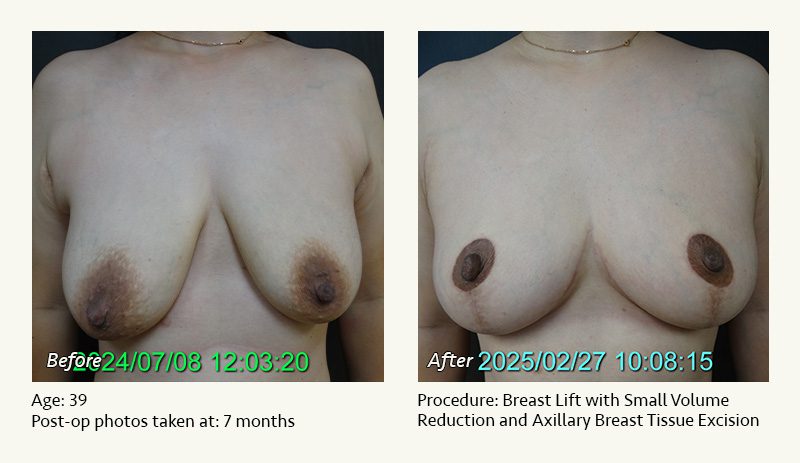
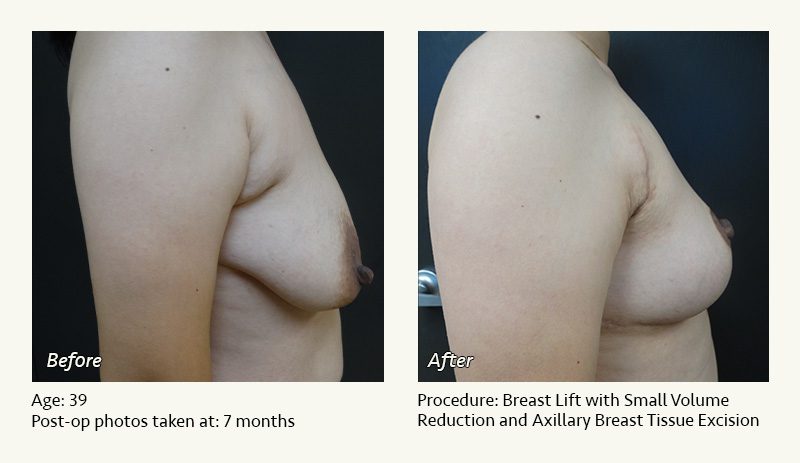
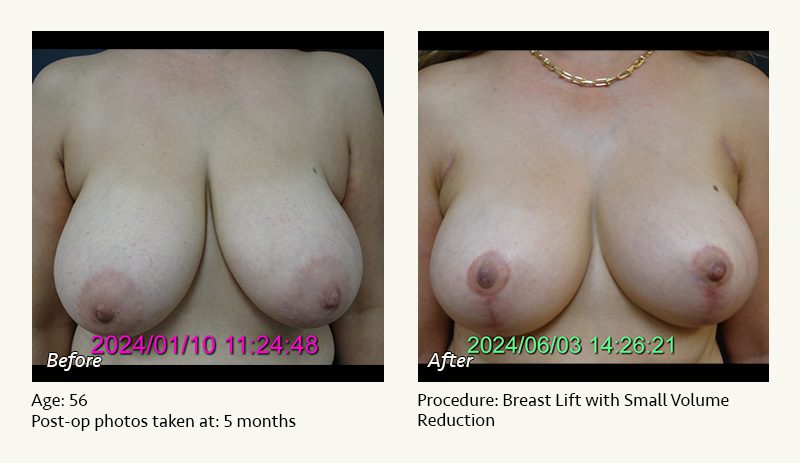
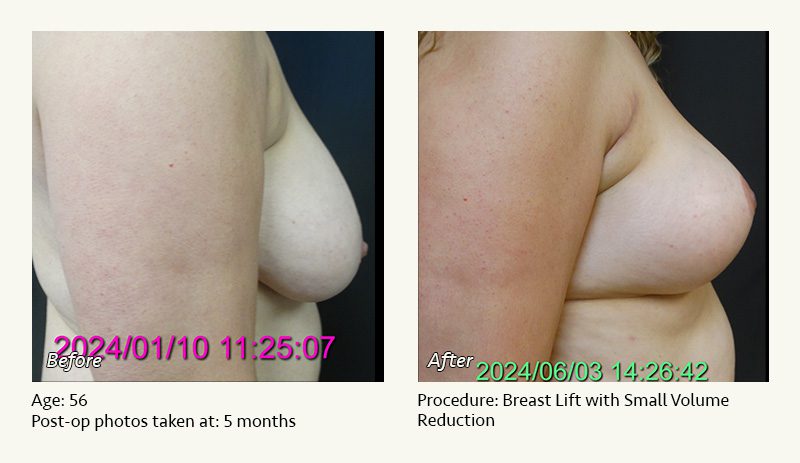
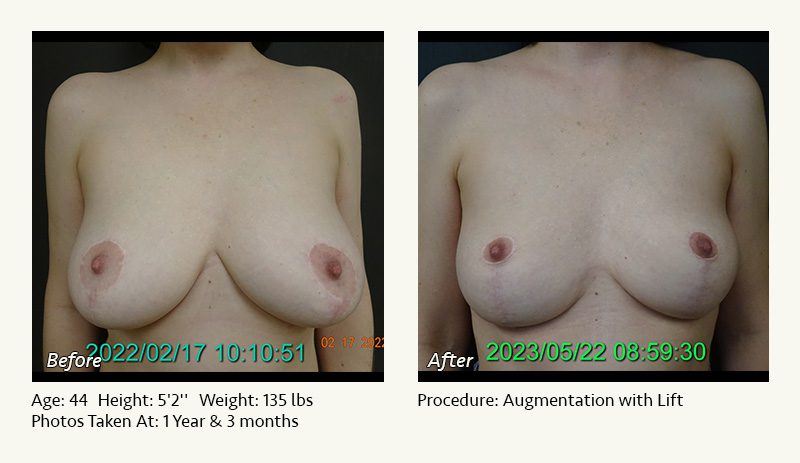
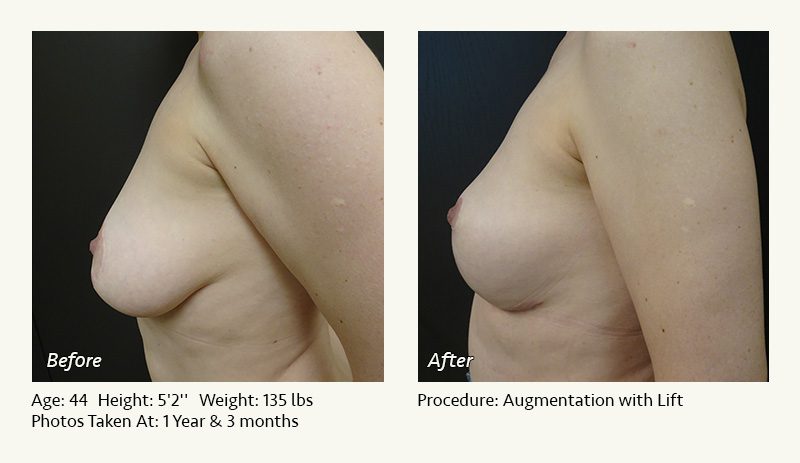
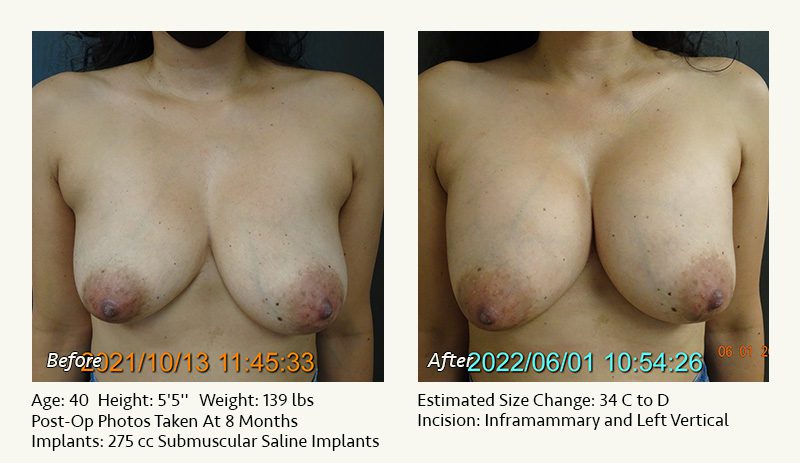
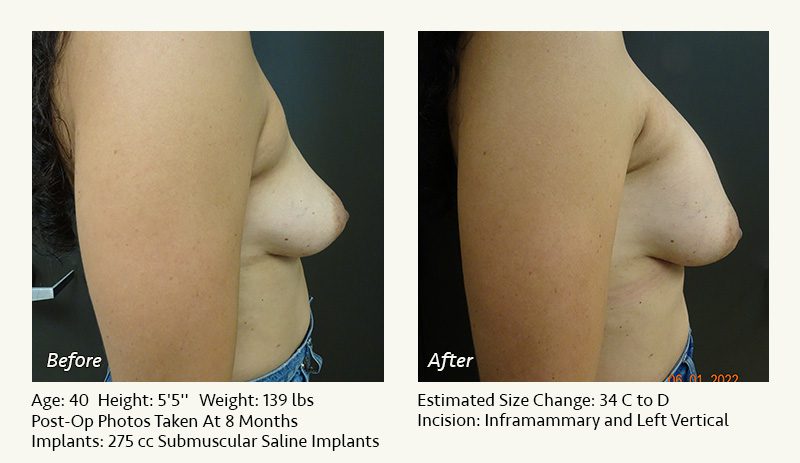
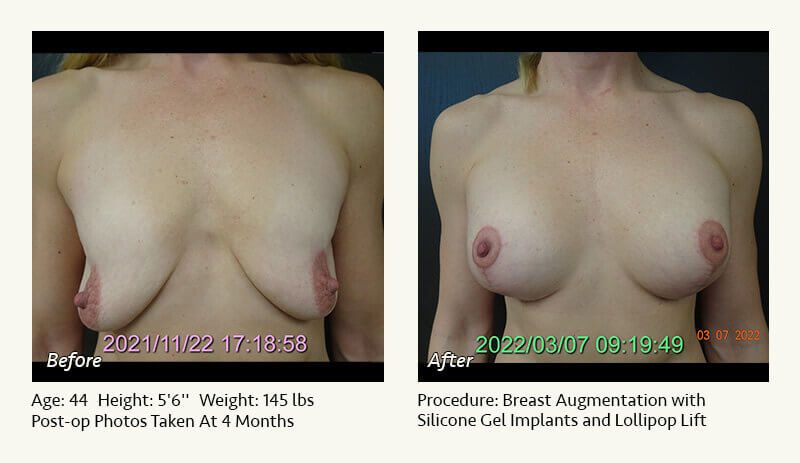
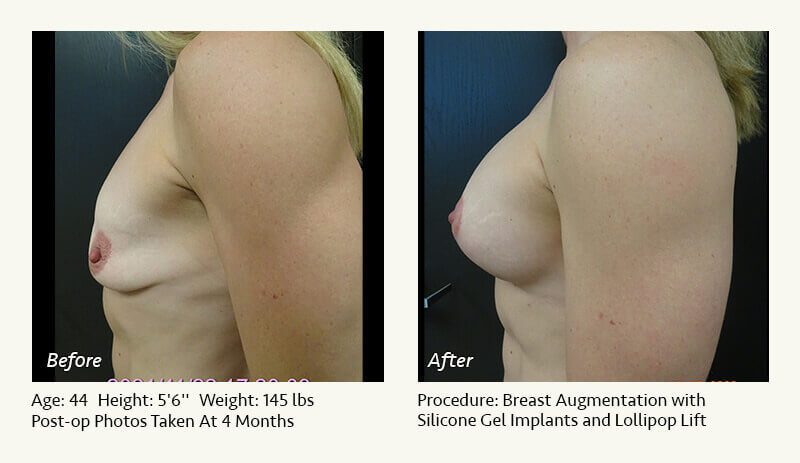
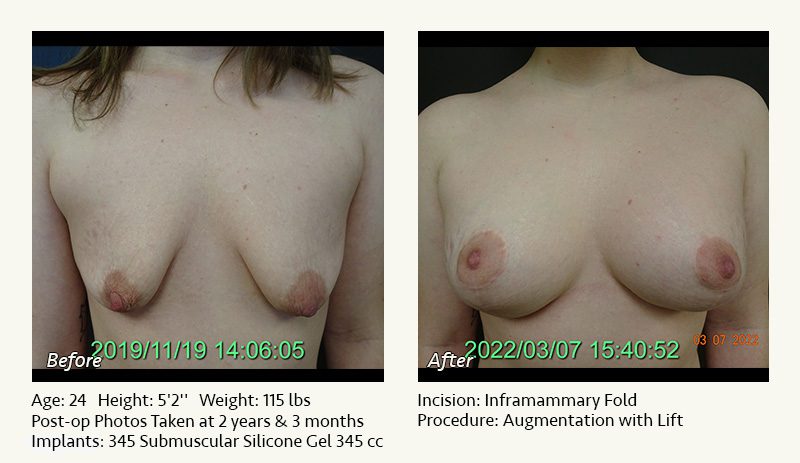
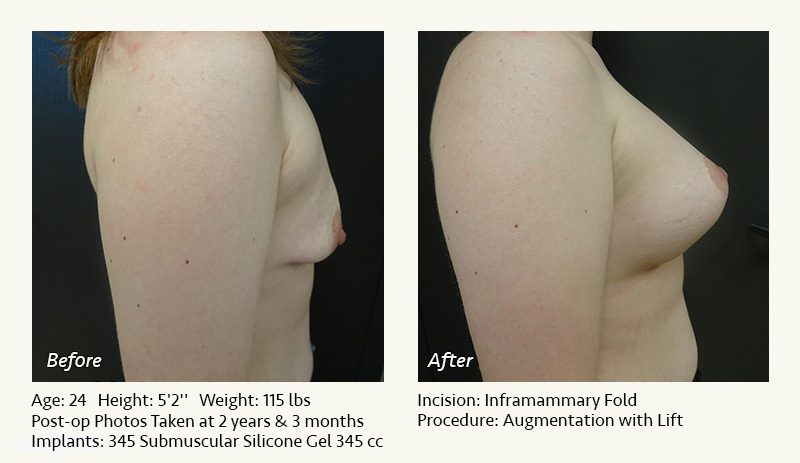
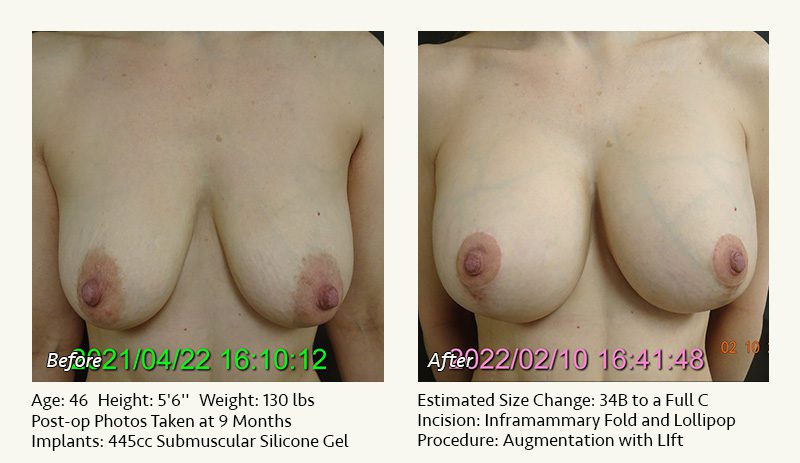
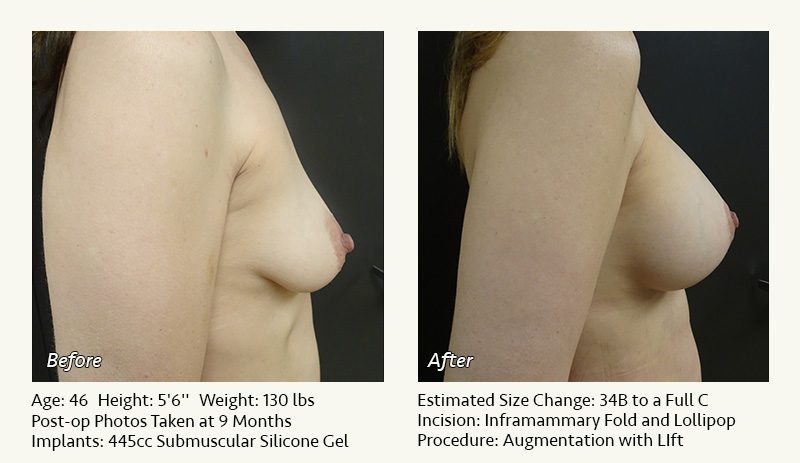
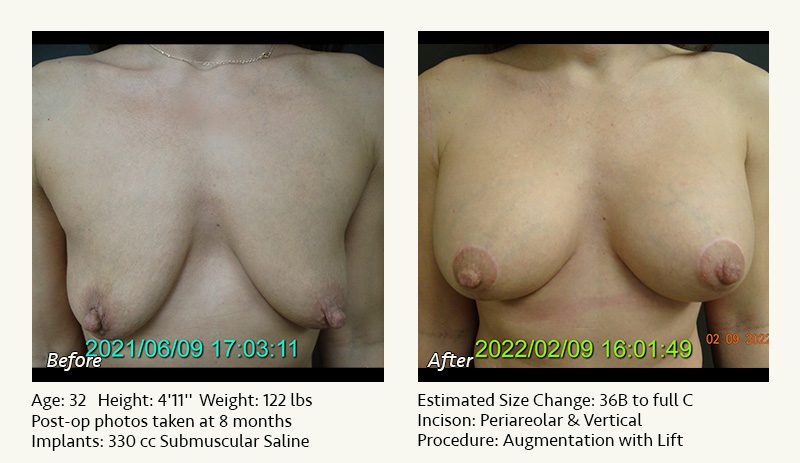
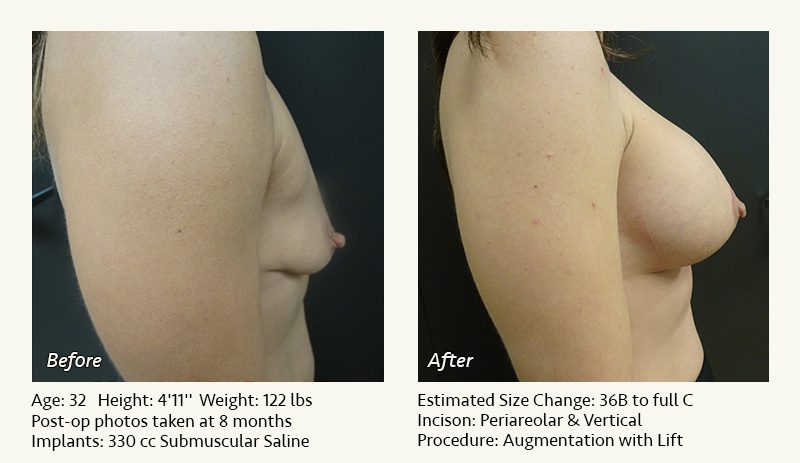
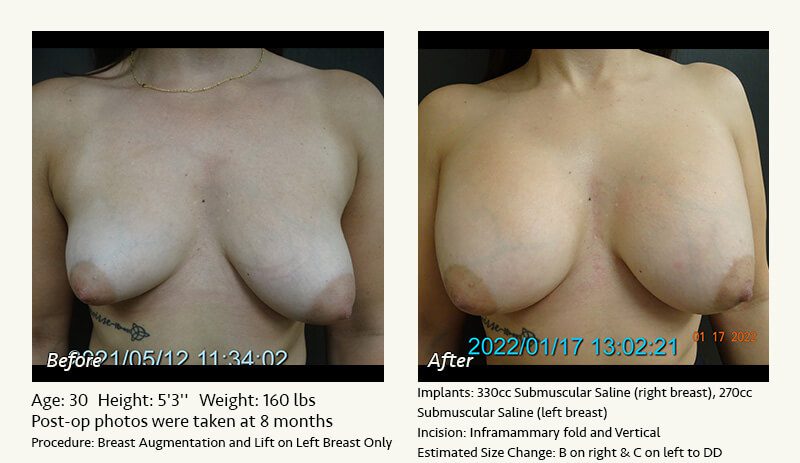
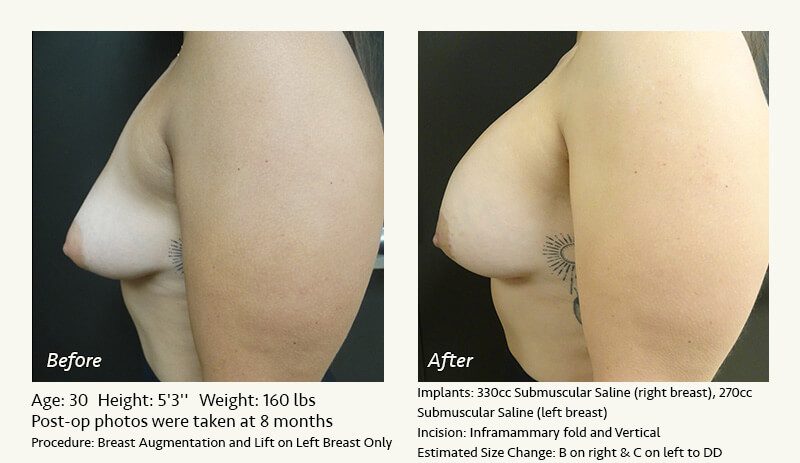
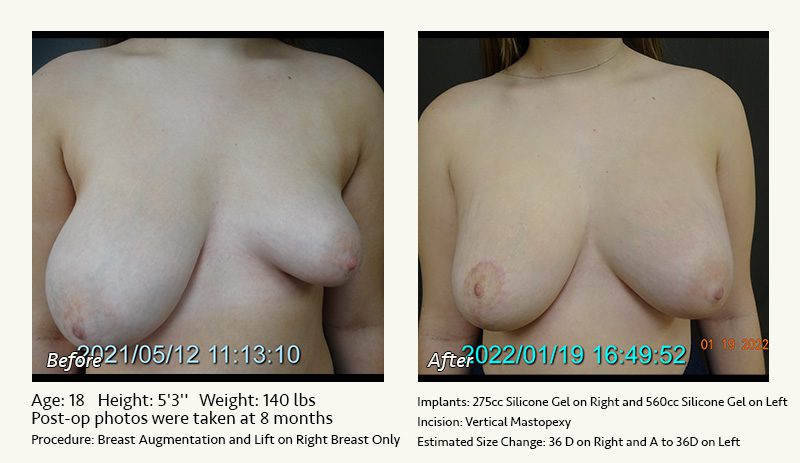
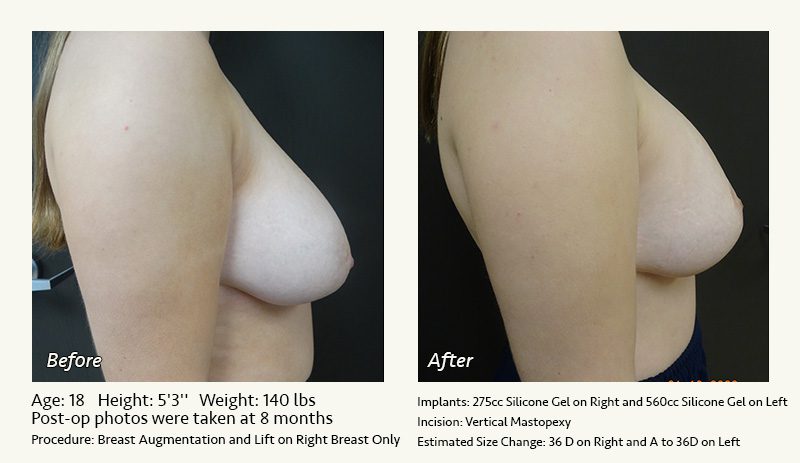
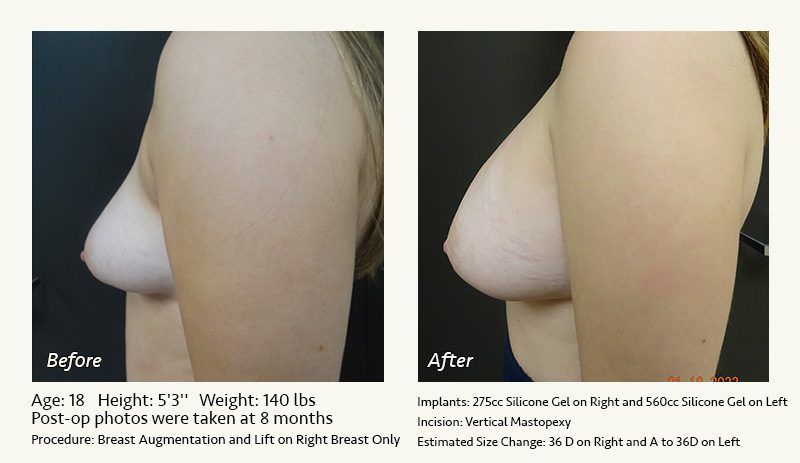
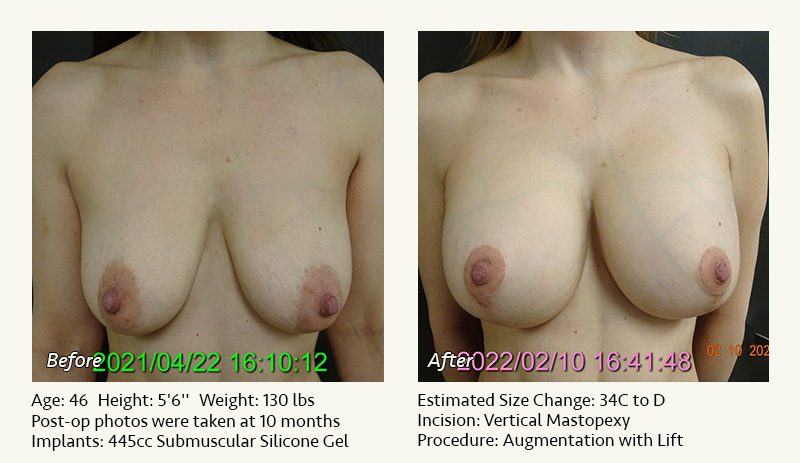
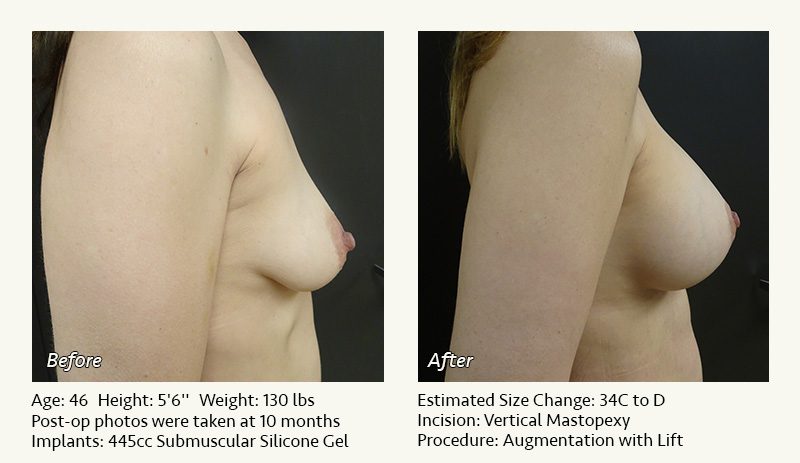
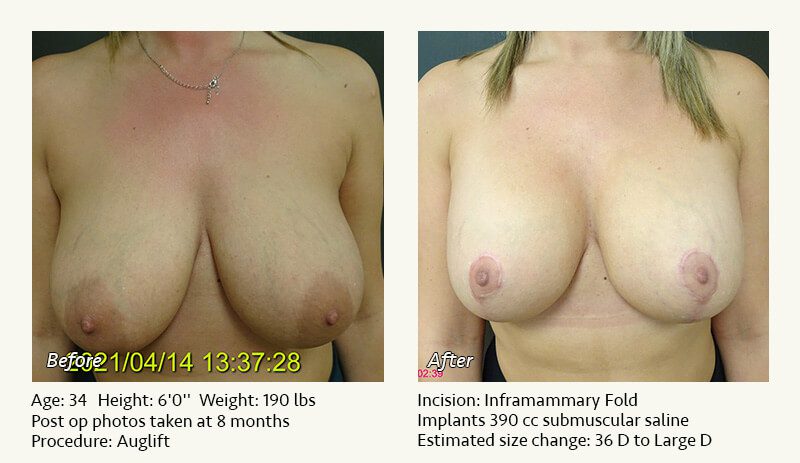
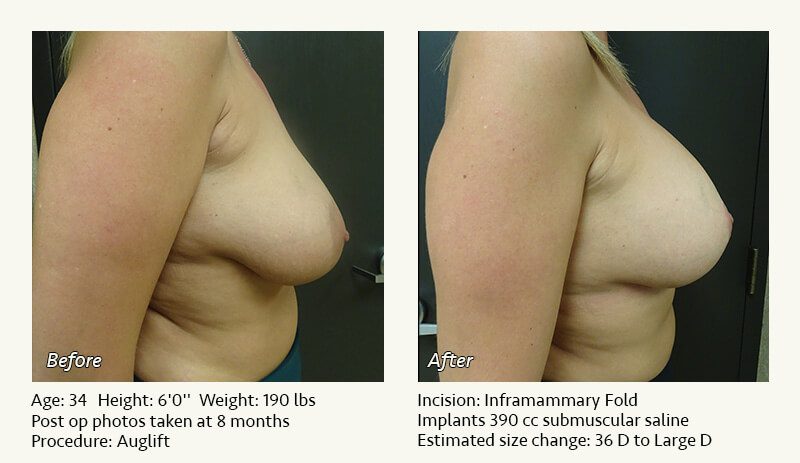
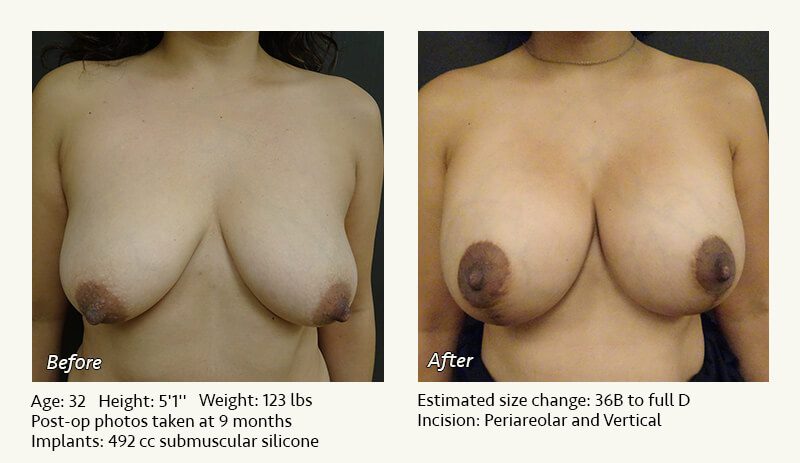
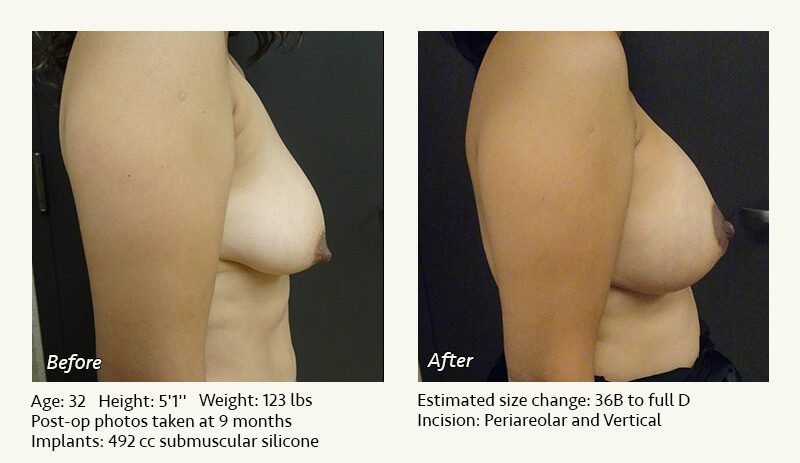
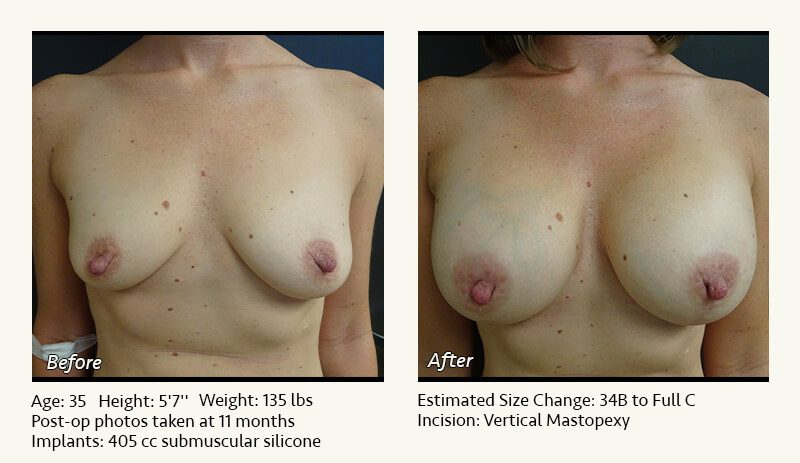
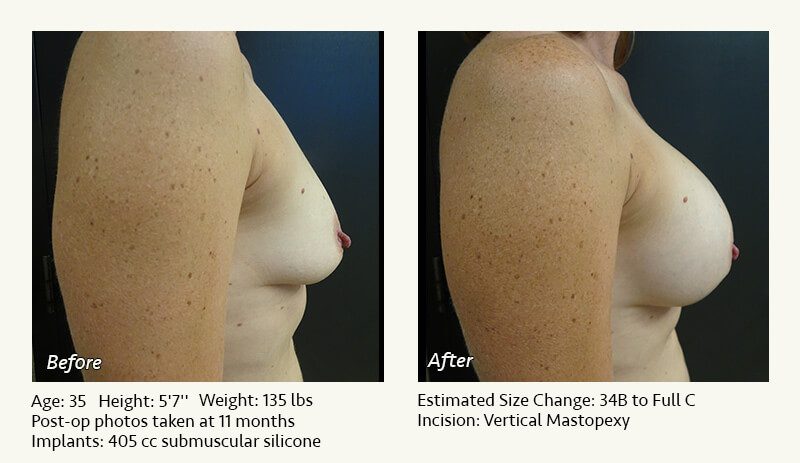
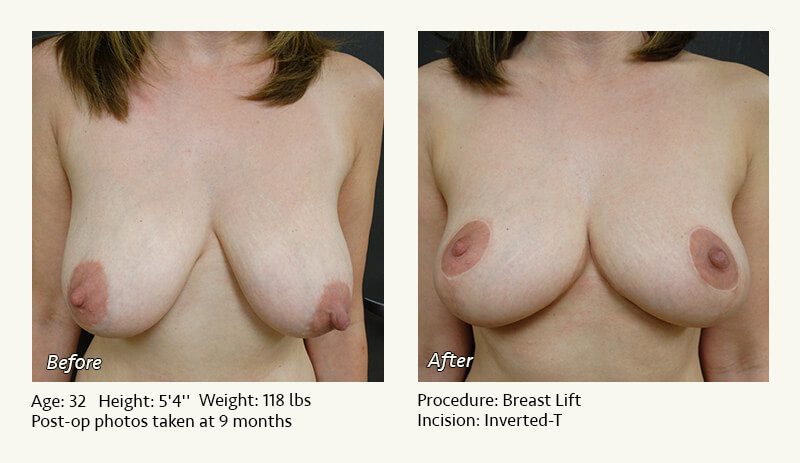
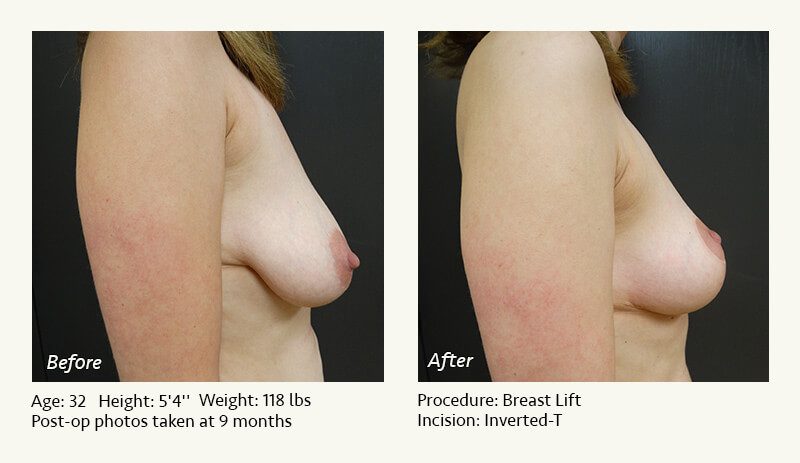
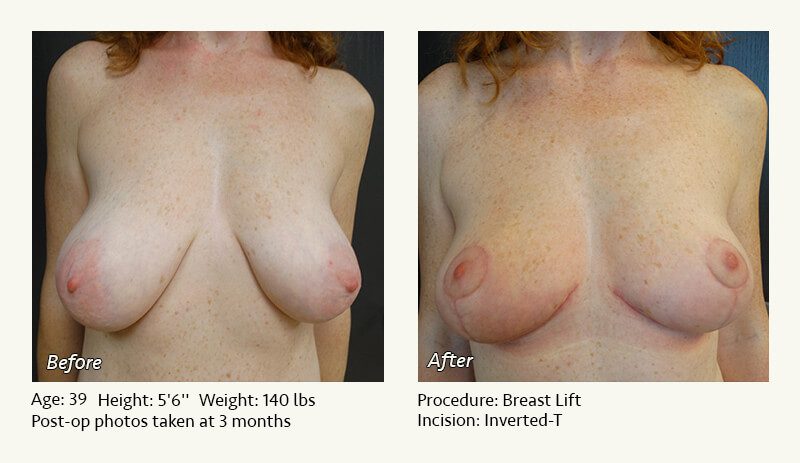
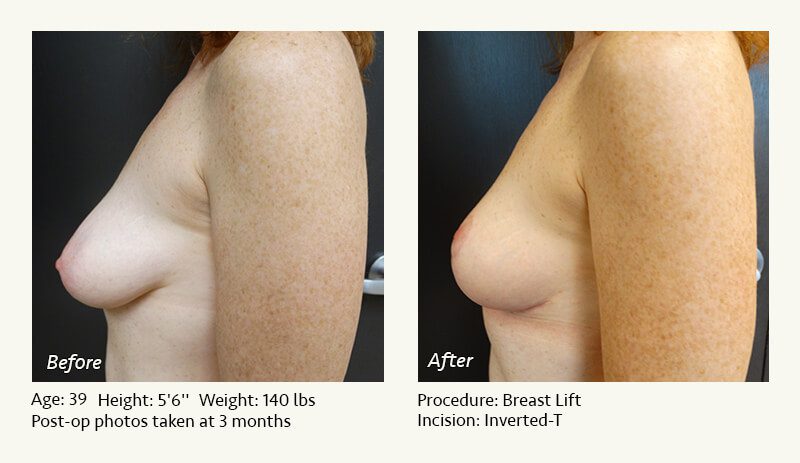
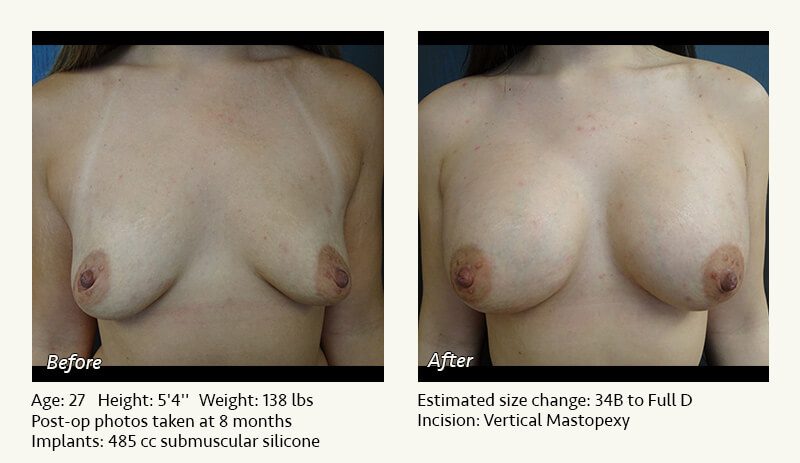
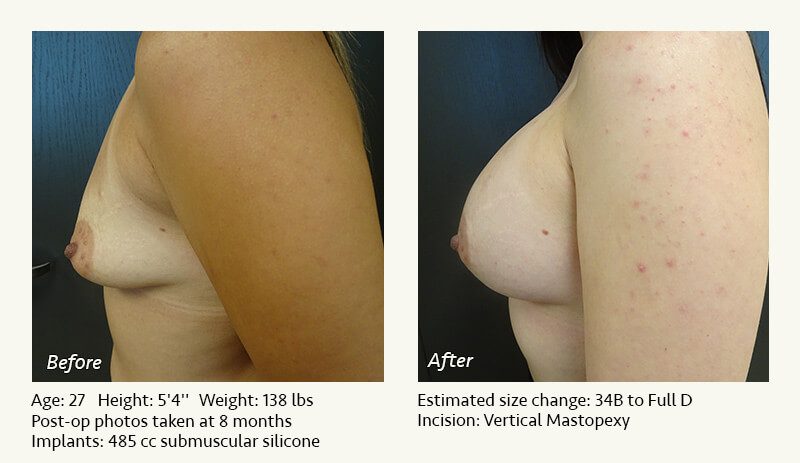
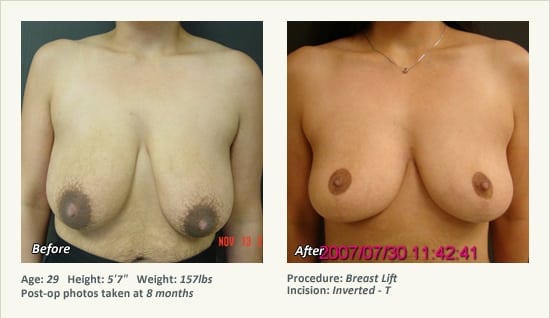
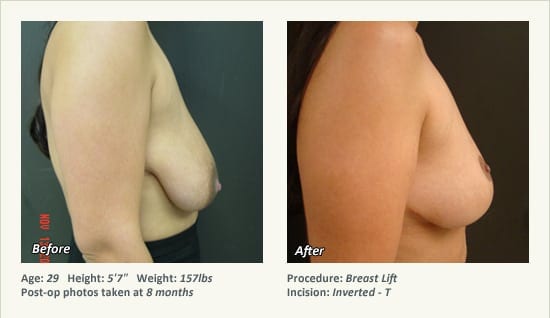
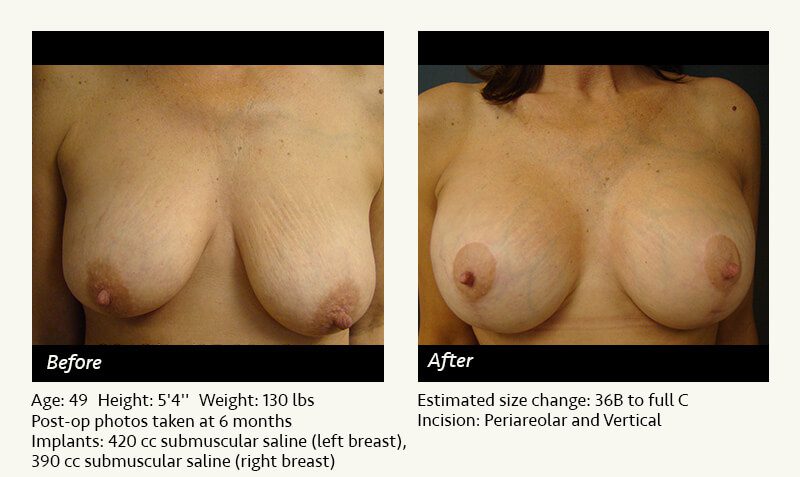
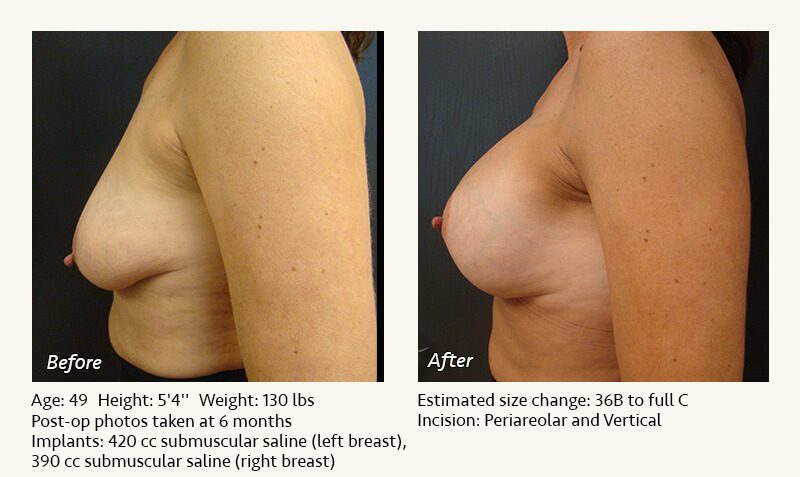
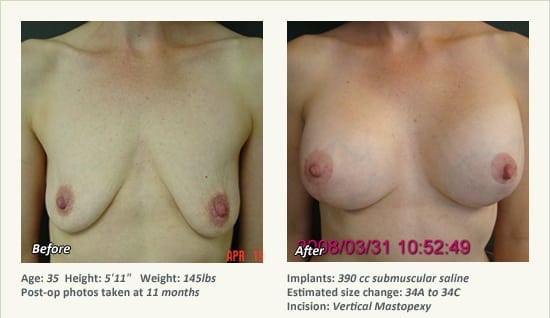
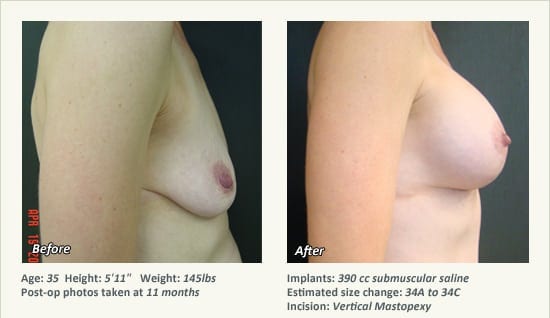
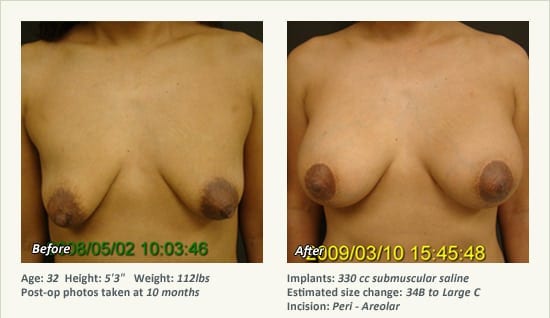
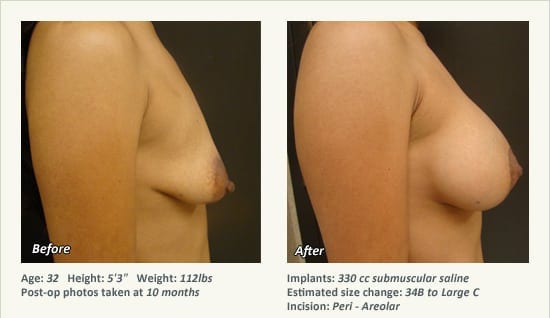
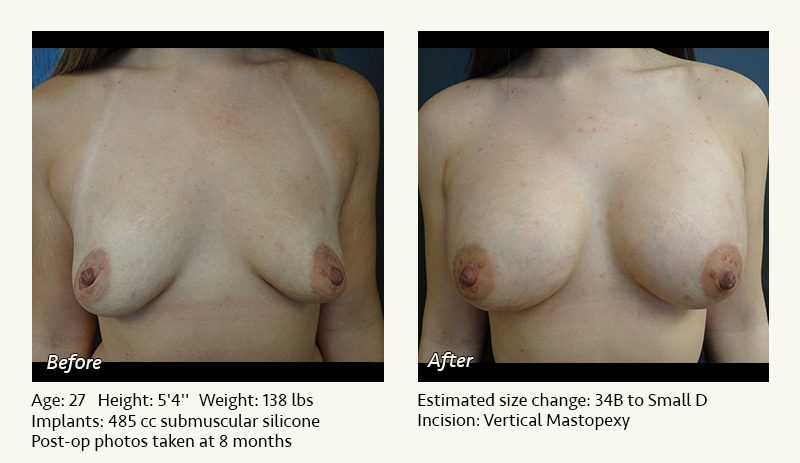
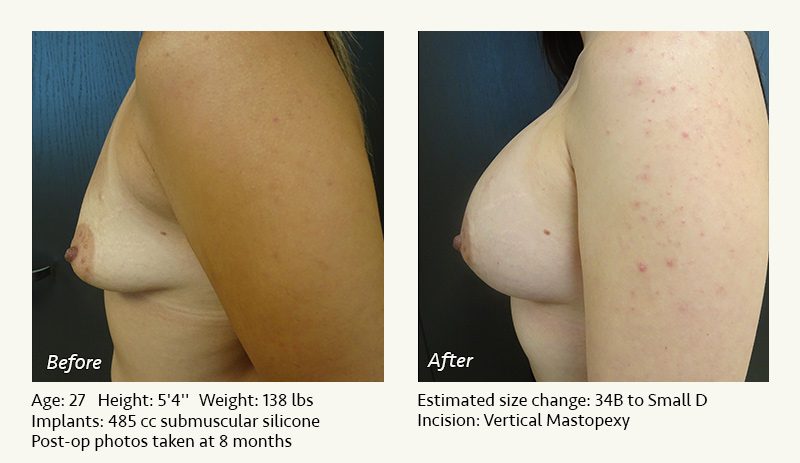
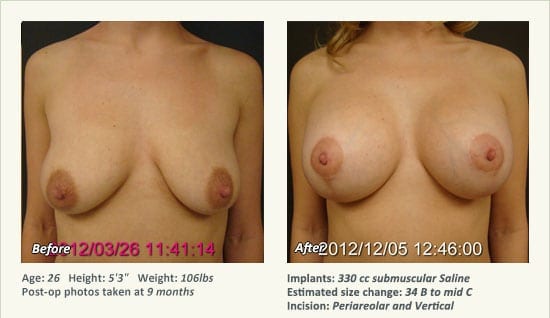
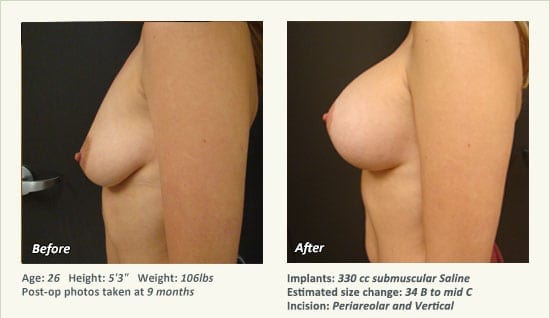
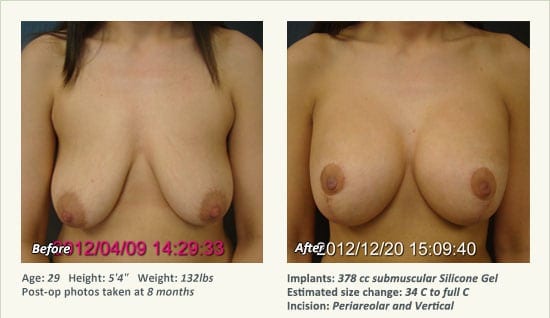
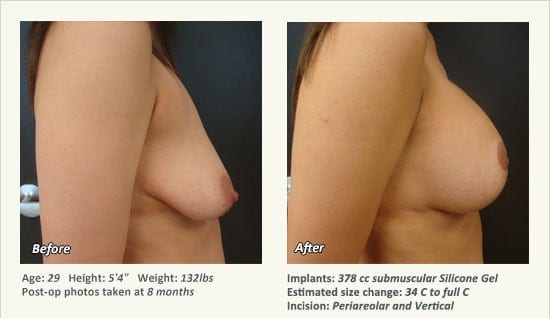
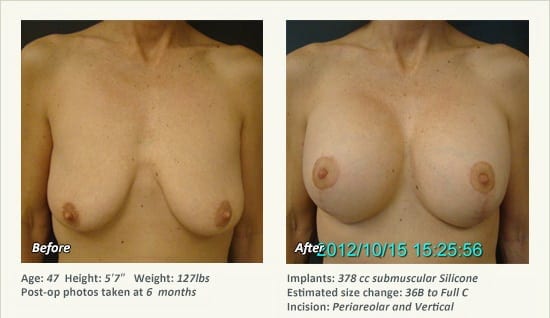
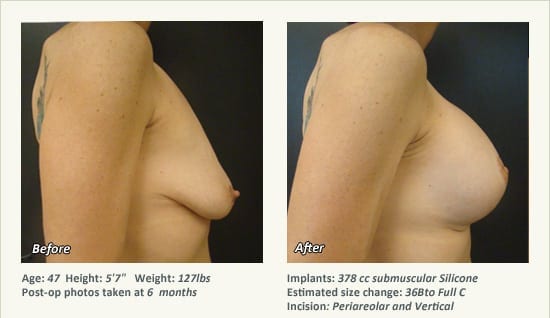
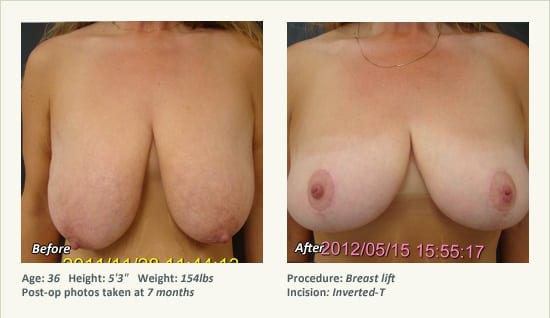
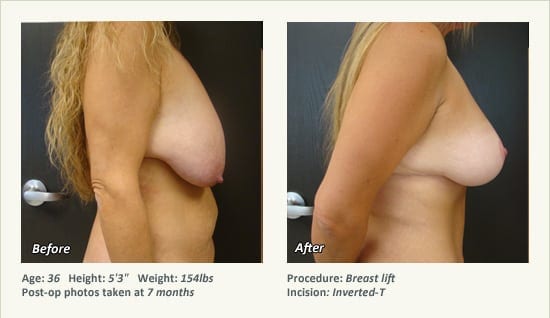
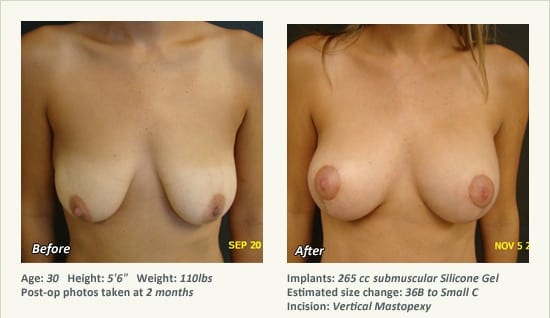
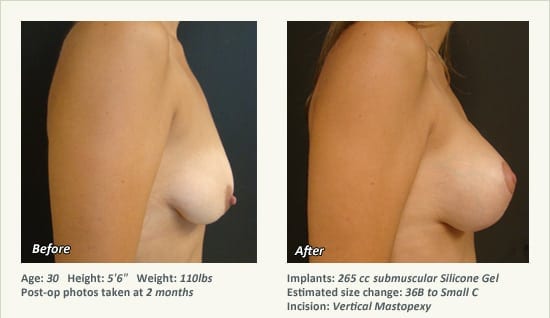
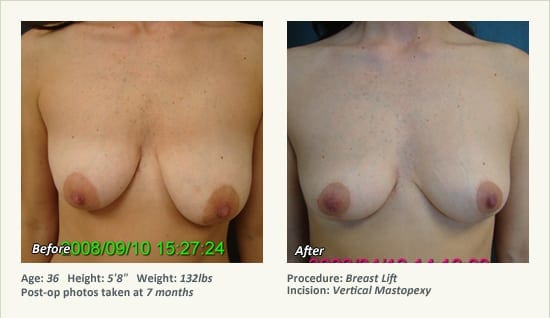
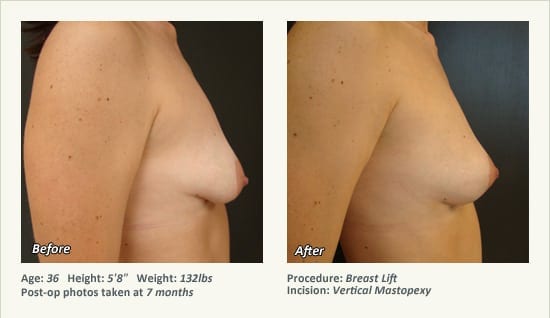
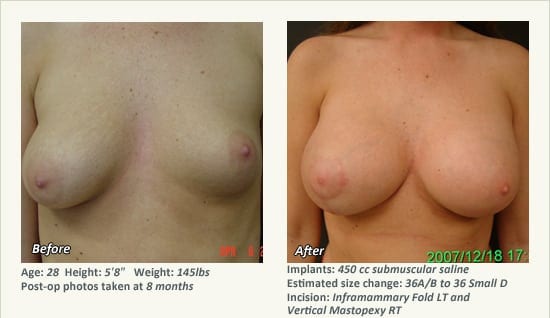
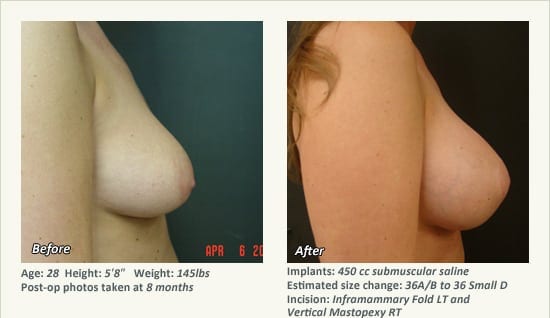
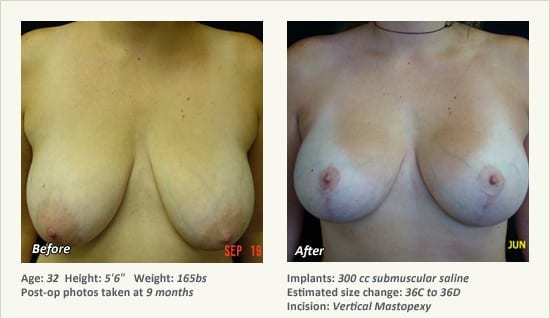
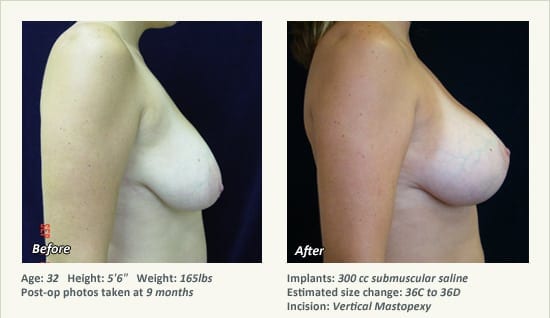
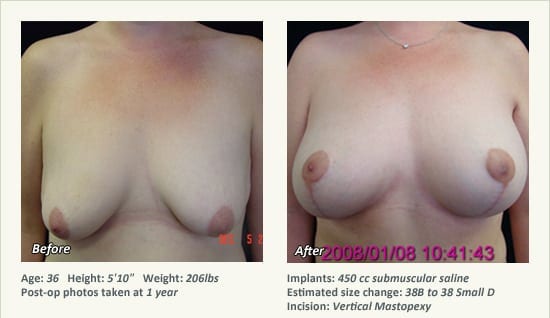
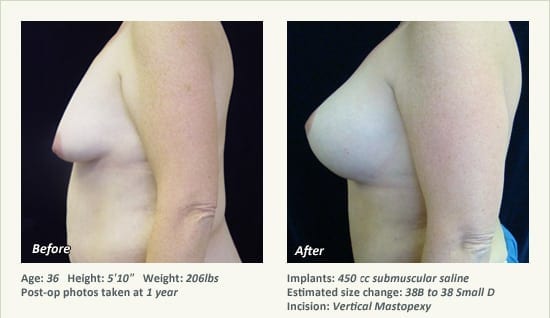
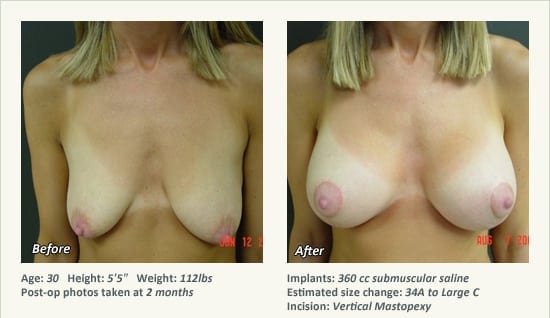
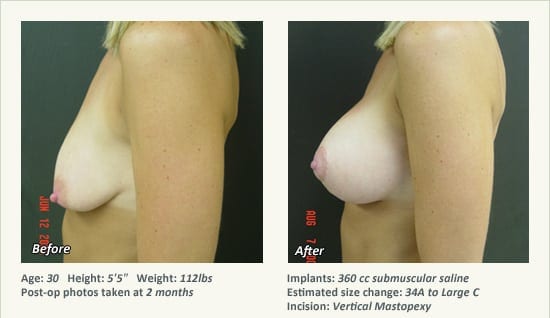
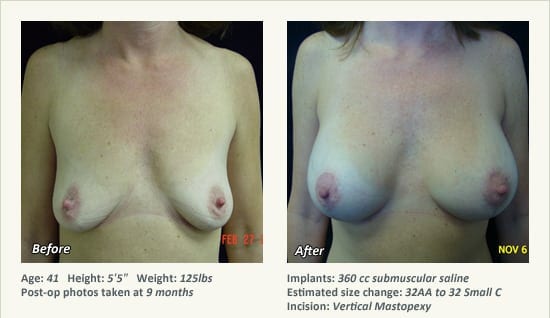
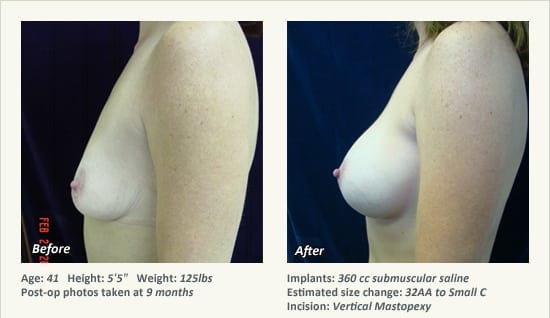
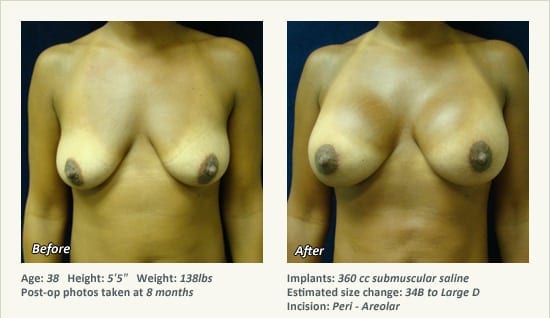
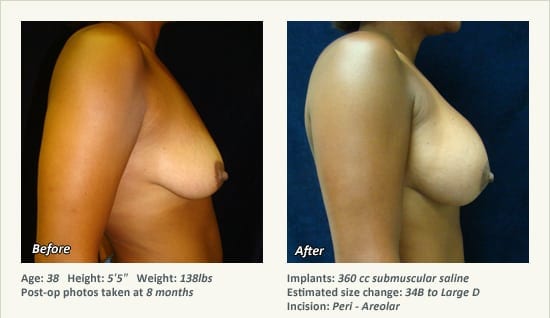
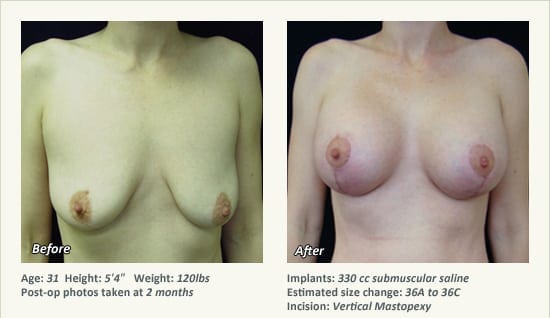
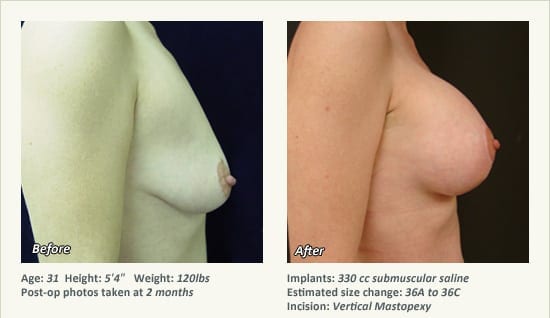
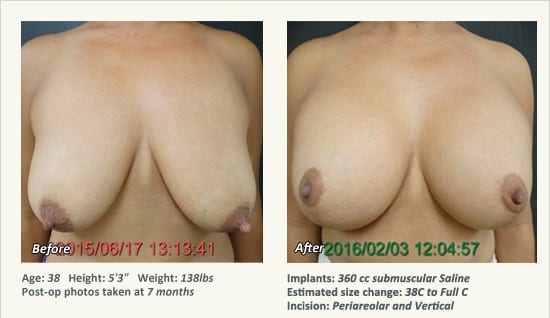
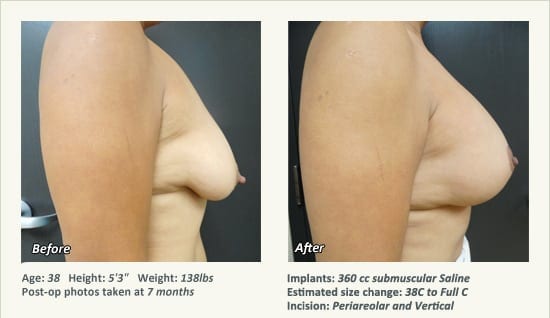
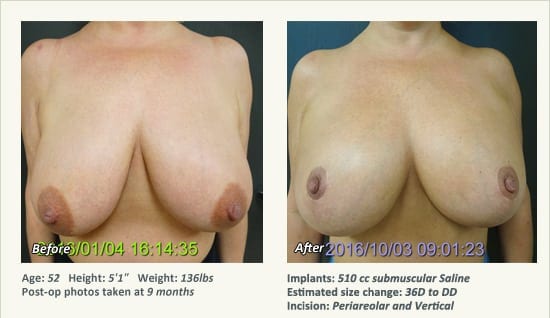
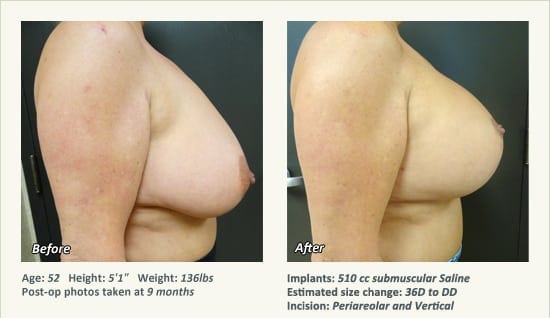
How Is Breast Lift Surgery Performed?
Dr. Friedman in Plano, Texas performs breast lift surgery under general anesthesia on an outpatient basis. The procedure is performed in his AAAASF-accredited surgical facility, the West Plano Plastic Surgery Center, which is located on the campus of Texas Health Presbyterian Hospital of Plano. He strictly uses physicians—not nurses or technicians—to administer your anesthesia.
To perform breast lift (with or without implants), incisions are placed around the nipple-areola. In most patients, a vertical incision extends from the bottom of the areola to the fold beneath the breast. Unlike most surgeons who perform breast lifts, Dr. Friedman typically does not place an extended horizontal incision in the fold beneath the breast except in women with severe sagging. There are no incisions on the upper breast. All sutures are internal. The incisions are sealed with a tissue glue (Dermabond). There are no external stitches, staples, compression bandages, or ACE wraps. Although there are scars from surgery, they generally fade over time.
Pain is usually mild and well-controlled with prescription pain medication. Most patients return to light activities within 3 to 5 days. Heavy lifting and chest workouts should be avoided for 6 weeks.
When you visit our office in Plano, Texas, we will be happy to show you what to expect from breast lift surgery. We will also show you a variety of “before and after” photos of breast lift procedures performed by Dr. Friedman. If you wish to speak to other women who have undergone breast lift with or without implants, we will be happy to provide phone numbers.
Why Do Breasts Sag?
In most women, sagging is caused by a combination of pregnancy, breastfeeding, aging, weight fluctuations, and/or genetics. Sagging occurs when there is too much breast skin, too little breast tissue, or both.
Am I a Good Candidate for Breast Lift Surgery?
You may be a good candidate for breast lift surgery if:
- Your breasts have become saggy, elongated, and flat.
- Your nipples are too low or point downward.
- Your areolae are stretched out and enlarged.
- One breast is lower than the other.
- You are healthy, and your weight is stable.
What Are My Options for Breast Lift Surgery?
There are several options:
- If sagging is mild, then breast augmentation alone may compensate for the loss of breast volume.
- If sagging is moderate and an increased breast size is desired, then breast augmentation with lift is recommended. The implants will also increase the fullness of the upper, inner breasts.
- If sagging is moderate to severe and breast volume is adequate, then breast lift (without implants) is recommended.
- If sagging is moderate to severe and the breasts are too large, then breast reduction will reduce breast size while simultaneously lifting the breasts.
How Do I Decide Whether to Have a Breast Lift, Breast Implants, or Both?
| Lift | Implants | Lift + Implants | |
| Improves breast sagging | ✓ | ✓ | |
| Improves nipple position | ✓ | ✓ | |
| Reduces areolar size | ✓ | ✓ | |
| Increases breast size | ✓ | ✓ | |
| Improves upper breast fullness | ✓ | ✓ | |
| Improves cleavage | ✓ | ✓ |
What Other Procedures Can I Combine With Breast Lift Surgery?
- Breast augmentation: over half of Dr. Friedman’s breast lift patients choose to undergo simultaneous breast augmentation to add upper breast fullness and cleavage.
- Breast reduction: some women would prefer a breast reduction in conjunction with lifting.
- Nipple procedures: inverted nipples, enlarged nipples, and sagging nipples may be addressed to improve the overall appearance of the breasts.
- Liposuction: many women choose liposuction of the abdomen, love handles, and/or “side boobs” to complement their perkier breasts.
- Tummy tuck: the same processes that cause the breasts to sag (pregnancy, weight changes, aging) can cause the abdomen to protrude and sag. The breasts and abdomen are frequently addressed at the same time.
- Mommy makeover: this includes any combination of breast and body contouring surgery to counteract the effects of pregnancy.
I Want Breast Implants. How Do I Decide Whether to Do a Lift Too?
Okay, so you’ve had a couple of kids and your breasts just don’t look the same anymore. They’ve lost fullness, especially up top, and they’ve gotten smaller and saggier. Can you get away with putting in breast implants (Fig. 1), or would you benefit from a breast lift too (Fig. 2)?

Figure 1: Breast Augmentation

Figure 2: Breast Augmentation with Lift
According to Dr. Friedman, the answer depends upon these factors:
- How much do your breasts sag?
Very simply, the more your breasts sag, the more likely you are to benefit from a breast lift (mastopexy). If only a small amount of tissue droops below the breast crease (inframammary fold), then you will probably do fine with breast implants alone. On the other hand, if your nipples are located below the folds (on profile view), then a breast lift is usually helpful. - Are you happy with your breast shape?
Breast enlargement is a great procedure for resizing the breasts, but it’s not very good at reshaping them. Yes, it’s true that saline and silicone gel breast implants will increase cleavage, fullness of the upper breasts, and breast projection. If that’s all you desire, then breast enlargement alone may be sufficient. However, if you are dissatisfied with the shape of your breasts prior to surgery, implants will not lift sagging tissues. If you have small, sagging breasts prior to surgery, implants alone will simply give you large, sagging breasts. - Are the tradeoffs worthwhile?
Positives of breast lift:
- Improved breast shape: your breasts will be perkier with reduction or elimination of sagging.
- Improved nipple-areolar size and position: Stretched-out areolae (the pigmented area around the nipple) can be reduced in size. The nipples will be higher and will generally point forward, rather than down.
- Improved breast symmetry: mastopexies can be tailored to lift one breast more than the other, obtaining better-matching breasts.
Negatives of breast lift:
- Additional scarring: depending upon the degree of drooping of the breasts, incisions will be made around the nipple-areola, vertically along the lower breast, and/or within the crease below the breast.
- Additional cost: breast lift with augmentation is a more complicated, longer procedure than breast implants alone. Accordingly, it is more expensive.
- Additional risks: breast lift carries its own risks separate and apart from those of breast enhancement.
According to Dr. Friedman, “Bottom line: if you are happy with your breast shape, position, and symmetry, then implants alone may give you the increased breast size, fullness, and cleavage that you are seeking. If you are unhappy with your breast shape, breast position on the chest wall, or have significant shape asymmetry, then an augmentation mastopexy (breast implants with breast lift) may be worth consideration.”
How Should I Prepare for Breast Lift Surgery?
One week before surgery
- Do not take aspirin-containing products, as these may increase your risk of bleeding. Use extra-strength Tylenol for any headaches or other minor pains.
- Please notify Dr. Friedman’s staff if you become sick with a fever, significant cough, etc. If necessary, your surgery can be rescheduled to a time when you are feeling better.
- Do not smoke at all or use a nicotine patch for at least two weeks (and preferably 4 weeks) prior to surgery and 4 weeks after surgery. Smoking interferes with wound healing and increases your risk for anesthetic and surgical complications.
- Arrange to have a relative or friend drive you home after surgery and stay with you for the evening. You cannot drive yourself home.
The evening before surgery
- Do not eat or drink anything for at least 8 hours prior to your scheduled surgery time.
- Make some jello and/or soup for after surgery. Have some juice in your refrigerator.
- The anesthesiologist will contact you by phone to discuss your medical history and to answer any questions.
Day of surgery: before you leave home
- Remember not to eat, drink, or smoke. This includes no chewing gum, mints, etc.
- Make sure someone is available to drive you home. Put a pillow and blanket in the car.
- Wear loose, comfortable clothing. Avoid heavy make-up, jewelry, or contact lenses.
- Please do not use any lotion, baby oil, perfume or powder.
- LEAVE ALL VALUABLES AT HOME!
Day of surgery: at the facility before surgery
- Dr. Friedman will talk to you before surgery to answer any last-minute questions. He will place drawings on your chest to help him accurately plan your surgery.
- You will meet the anesthesiologist and surgical nurses.
Day of surgery: at the facility after surgery
- You will be taken to the recovery area to wake up after surgery. Dr. Friedman will go to the waiting room to speak to your family/friends.
- Approximately 1 hour later, your family can visit you. Once you are feeling well enough, you may go home.
At home after surgery
- Have someone stay with you for the first night. You may be weak and drowsy.
- Take the antibiotics, pain medication (as needed), and anti-nausea medicine (if needed) that Dr. Friedman has prescribed for you.
- Sleep with your head elevated. Sleep on your back (not your stomach or side).
- Keep your dressings (gauze and tape) clean and dry. Do not remove the dressings. You may shower only from the waist down. You may wish to sponge bathe.
- Take at least 10 deep breaths every hour. This will help keep your lungs expanded.
- Do not be a couch potato. To reduce the risk of blood clots in the legs, get up and walk any time you eat or need the bathroom. While you are in bed, repeatedly flex your ankles (moving your toes up and then down) and/or have your family massage your calves.
- If you experience a prolonged fever (oral temperature greater than 101), contact Dr. Friedman. Feel free to call our office or to page Dr. Friedman for any other problems or concerns.
How Do I Recover From Breast Lift Surgery?
Instructions for your first postoperative visit (about one week after surgery)
- Activity level
1 Week after surgery: you may resume casual walking but must not engage in vigorous exercise that increases your blood pressure or heart rate. You may resume driving once you are off of your pain medication. Avoid freeways until you are comfortable with city driving.3 Weeks after surgery: you may resume jogging (with a jog bra) or an elliptical trainer but must avoid vigorous use of your chest or arms.6 Weeks after surgery: you may gradually resume exercise involving the chest and arms. Only now may you lift more than 5 pounds. - Sleeping position
Please sleep on your back (flat or elevated) or part way over (pillow under your shoulder and hip). Do not sleep on your side until about 3 weeks after surgery. Unless otherwise instructed by Dr. Friedman, do not sleep on your stomach until about 8 weeks after surgery. - Incision care
You have a layer of tissue glue to seal your incision. After this peels off (about 2 weeks after surgery), begin scar massage with Mederma twice daily. Mederma is available at our front desk or over-the-counter at your pharmacy. If you prefer, you may use Vitamin E or Aloe Vera. Continue scar massage for about 3 months. - Bra usage
You may begin to use a bra, ideally a sports bra or one that snaps in the front. Do not wear an underwire bra for at least 3 months following surgery unless instructed to do so by Dr. Friedman. - Water exposure
You may begin light showers 48 hours after your drains are removed. You should avoid scrubbing your incisions. Do not immerse your breasts under water in a bathtub for 4 weeks. Avoid immersing your breasts in a pool, lake, or ocean for 6 weeks. - Medications
One week after surgery, you may resume use of any medications or supplements that you discontinued prior to surgery. However, for at least 3 weeks, you should avoid Motrin, aspirin, and any other product that may thin your blood. - Smoking
Do not smoke for at least one month (and preferably much longer) after surgery. Smoking may increase your risk of infection, lung problems following anesthesia, and wound healing problems. - Tanning
You may tan your breasts whenever you like. However, you should avoid tanning directly over your incisions for at least 6 months. Premature tanning of the incisions may cause them to darken permanently. - Sex
You may resume intercourse in a non-weight bearing position (i.e. on your side) about 3 weeks after surgery. You may not bear weight on your chest for at least 6 weeks. - Dental visits
If you have had breast augmentation (in addition to breast lift), avoid dental cleanings/fillings for 6 weeks, as bacteria in your gums can be transmitted to your implants via your bloodstream.
Please feel free to ask Dr. Friedman or his staff about any additional questions or concerns.
Q & A: Breast Lift
-
If I put in big enough implants, can I avoid doing a lift?
If sagging is mild, breast implants may be sufficient to provide the illusion of some lifting. However, implants do not actually lift the breasts, as they have no built-in “anti-gravity” device. If you have a moderate to severe degree of sagging, placing very large implants (without performing a breast lift) will add much greater weight to the breasts and may actually worsen the sagging.
-
What is an “anchor lift?”
An anchor lift involves extended horizontal incisions at or near the folds beneath the breasts, in addition to the usual incisions around the nipple-areola and vertically along the lower breasts. These incisions, which form an anchor-shaped pattern, are used by many surgeons. Dr. Friedman generally does not use an anchor incision to perform breast augmentation with lift except in women with severe sagging.
-
Is there any reason to do breast lift and breast augmentation separately?
In most women, Dr. Friedman performs breast lift and augmentation simultaneously. However, in women with severe sagging of the breasts, Dr. Friedman may recommend breast lift alone, perhaps followed at a later date by breast augmentation. In this circumstance, he believes that the results of separately performed procedures may be more predictable and reliable than simultaneous procedures.
-
How visible are the scars?
Every woman scars differently. However, the scars around the nipple-areola and along the upper portion of the vertical incision are generally fine lines and relatively inconspicuous. The lower part of the vertical scar (hidden near the fold beneath the breast) frequently widens to some degree, as this portion of the scar bears the most weight and tension.
-
Will my breasts sag again after surgery?
Your breasts will remain “perkier” after surgery than they did before. However, time and gravity are still concerns after surgery. Therefore, you should wear a support bra (as you did prior to surgery) to maximize the longevity of your results.